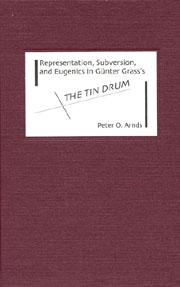Book contents
- Frontmatter
- Contents
- Acknowledgments
- Abbreviations
- Introduction
- 1 Representing Euthanasia; Reclaiming Popular Culture
- 2 Heteroglossia from Grimmelshausen to the Grimm Brothers
- 3 The Dwarf and Nazi Body Politics
- 4 Oskar's Dysfunctional Family and Gender Politics
- 5 Oskar as Fool, Harlequin, and Trickster, and the Politics of Sanity
- 6 Gypsies, the Picaresque Novel, and the Politics of Social Integration
- Epilogue: Beyond Die Blechtrommel: Germans as Victims in Im Krebsgang
- Works Cited
- Index
1 - Representing Euthanasia; Reclaiming Popular Culture
Published online by Cambridge University Press: 05 February 2013
- Frontmatter
- Contents
- Acknowledgments
- Abbreviations
- Introduction
- 1 Representing Euthanasia; Reclaiming Popular Culture
- 2 Heteroglossia from Grimmelshausen to the Grimm Brothers
- 3 The Dwarf and Nazi Body Politics
- 4 Oskar's Dysfunctional Family and Gender Politics
- 5 Oskar as Fool, Harlequin, and Trickster, and the Politics of Sanity
- 6 Gypsies, the Picaresque Novel, and the Politics of Social Integration
- Epilogue: Beyond Die Blechtrommel: Germans as Victims in Im Krebsgang
- Works Cited
- Index
Summary
Historical Context
Before elaborating on Grass's strategies in his use of popular culture, this study must address a pivotal question: to what extent does Oskar become a victim of Nazi persecution? The novel has two temporal levels that converge at the end: the period from 1952 to 1954, during which Oskar Matzerath is an inmate of a mental asylum, from where he narrates his story, and the retrospective account of his life, which starts in 1899 and ends with his thirtieth birthday in September 1954. The central historical periods are the Third Reich and the postwar years. Oskar witnesses this time from the perspective of a dwarf who vacillates between resistance to and involvement in Nazi activities. In 1935 Oskar's drumming breaks up a Nazi party rally; in the winter of 1936–37 his voice destroys the shop windows in Gdansk, a prelude to the “night of broken glass” of November 1938.1 The novel describes the beginning of the Second World War: Oskar in a Polish post office, the Russian invasion; and it shows Oskar as a Nazi entertainer on the western front. The end of the war is marked by his physical transformation. He grows a few inches and develops a hump as he is escaping to West Germany with his mistress/stepmother Maria and his son Kurt. The next phase shows Oskar trying to become fully integrated into West German society, an attempt that ultimately fails.
- Type
- Chapter
- Information
- Publisher: Boydell & BrewerPrint publication year: 2004



